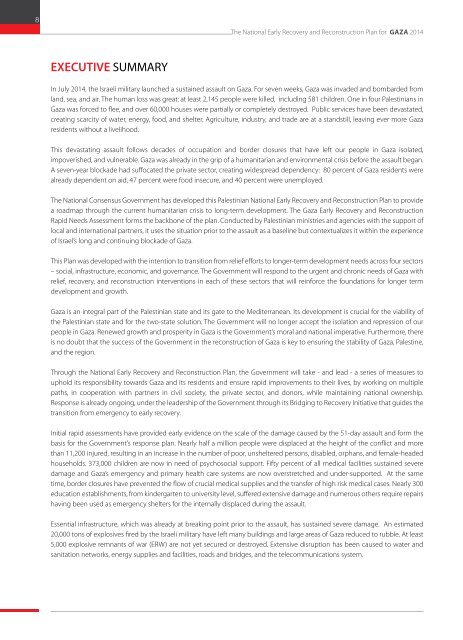National Early Recovery and Reconstruction Plan for Gaza 2014-2017_FINAL...
National Early Recovery and Reconstruction Plan for Gaza 2014-2017_FINAL...
National Early Recovery and Reconstruction Plan for Gaza 2014-2017_FINAL...
Create successful ePaper yourself
Turn your PDF publications into a flip-book with our unique Google optimized e-Paper software.
8<br />
The <strong>National</strong> <strong>Early</strong> <strong>Recovery</strong> <strong>and</strong> <strong>Reconstruction</strong> <strong>Plan</strong> <strong>for</strong> <strong>Gaza</strong> <strong>2014</strong><br />
EXECUTIVE SUMMARY<br />
In July <strong>2014</strong>, the Israeli military launched a sustained assault on <strong>Gaza</strong>. For seven weeks, <strong>Gaza</strong> was invaded <strong>and</strong> bombarded from<br />
l<strong>and</strong>, sea, <strong>and</strong> air. The human loss was great: at least 2,145 people were killed, including 581 children. One in four Palestinians in<br />
<strong>Gaza</strong> was <strong>for</strong>ced to flee, <strong>and</strong> over 60,000 houses were partially or completely destroyed. Public services have been devastated,<br />
creating scarcity of water, energy, food, <strong>and</strong> shelter. Agriculture, industry, <strong>and</strong> trade are at a st<strong>and</strong>still, leaving ever more <strong>Gaza</strong><br />
residents without a livelihood.<br />
This devastating assault follows decades of occupation <strong>and</strong> border closures that have left our people in <strong>Gaza</strong> isolated,<br />
impoverished, <strong>and</strong> vulnerable. <strong>Gaza</strong> was already in the grip of a humanitarian <strong>and</strong> environmental crisis be<strong>for</strong>e the assault began.<br />
A seven-year blockade had suffocated the private sector, creating widespread dependency: 80 percent of <strong>Gaza</strong> residents were<br />
already dependent on aid, 47 percent were food insecure, <strong>and</strong> 40 percent were unemployed.<br />
The <strong>National</strong> Consensus Government has developed this Palestinian <strong>National</strong> <strong>Early</strong> <strong>Recovery</strong> <strong>and</strong> <strong>Reconstruction</strong> <strong>Plan</strong> to provide<br />
a roadmap through the current humanitarian crisis to long-term development. The <strong>Gaza</strong> <strong>Early</strong> <strong>Recovery</strong> <strong>and</strong> <strong>Reconstruction</strong><br />
Rapid Needs Assessment <strong>for</strong>ms the backbone of the plan. Conducted by Palestinian ministries <strong>and</strong> agencies with the support of<br />
local <strong>and</strong> international partners, it uses the situation prior to the assault as a baseline but contextualizes it within the experience<br />
of Israel’s long <strong>and</strong> continuing blockade of <strong>Gaza</strong>.<br />
This <strong>Plan</strong> was developed with the intention to transition from relief ef<strong>for</strong>ts to longer-term development needs across four sectors<br />
– social, infrastructure, economic, <strong>and</strong> governance. The Government will respond to the urgent <strong>and</strong> chronic needs of <strong>Gaza</strong> with<br />
relief, recovery, <strong>and</strong> reconstruction interventions in each of these sectors that will rein<strong>for</strong>ce the foundations <strong>for</strong> longer term<br />
development <strong>and</strong> growth.<br />
<strong>Gaza</strong> is an integral part of the Palestinian state <strong>and</strong> its gate to the Mediterranean. Its development is crucial <strong>for</strong> the viability of<br />
the Palestinian state <strong>and</strong> <strong>for</strong> the two-state solution. The Government will no longer accept the isolation <strong>and</strong> repression of our<br />
people in <strong>Gaza</strong>. Renewed growth <strong>and</strong> prosperity in <strong>Gaza</strong> is the Government’s moral <strong>and</strong> national imperative. Furthermore, there<br />
is no doubt that the success of the Government in the reconstruction of <strong>Gaza</strong> is key to ensuring the stability of <strong>Gaza</strong>, Palestine,<br />
<strong>and</strong> the region.<br />
Through the <strong>National</strong> <strong>Early</strong> <strong>Recovery</strong> <strong>and</strong> <strong>Reconstruction</strong> <strong>Plan</strong>, the Government will take - <strong>and</strong> lead - a series of measures to<br />
uphold its responsibility towards <strong>Gaza</strong> <strong>and</strong> its residents <strong>and</strong> ensure rapid improvements to their lives, by working on multiple<br />
paths, in cooperation with partners in civil society, the private sector, <strong>and</strong> donors, while maintaining national ownership.<br />
Response is already ongoing, under the leadership of the Government through its Bridging to <strong>Recovery</strong> Initiative that guides the<br />
transition from emergency to early recovery.<br />
Initial rapid assessments have provided early evidence on the scale of the damage caused by the 51-day assault <strong>and</strong> <strong>for</strong>m the<br />
basis <strong>for</strong> the Government’s response plan. Nearly half a million people were displaced at the height of the conflict <strong>and</strong> more<br />
than 11,200 injured, resulting in an increase in the number of poor, unsheltered persons, disabled, orphans, <strong>and</strong> female-headed<br />
households. 373,000 children are now in need of psychosocial support. Fifty percent of all medical facilities sustained severe<br />
damage <strong>and</strong> <strong>Gaza</strong>’s emergency <strong>and</strong> primary health care systems are now overstretched <strong>and</strong> under-supported. At the same<br />
time, border closures have prevented the flow of crucial medical supplies <strong>and</strong> the transfer of high risk medical cases. Nearly 300<br />
education establishments, from kindergarten to university level, suffered extensive damage <strong>and</strong> numerous others require repairs<br />
having been used as emergency shelters <strong>for</strong> the internally displaced during the assault.<br />
Essential infrastructure, which was already at breaking point prior to the assault, has sustained severe damage. An estimated<br />
20,000 tons of explosives fired by the Israeli military have left many buildings <strong>and</strong> large areas of <strong>Gaza</strong> reduced to rubble. At least<br />
5,000 explosive remnants of war (ERW) are not yet secured or destroyed. Extensive disruption has been caused to water <strong>and</strong><br />
sanitation networks, energy supplies <strong>and</strong> facilities, roads <strong>and</strong> bridges, <strong>and</strong> the telecommunications system.


